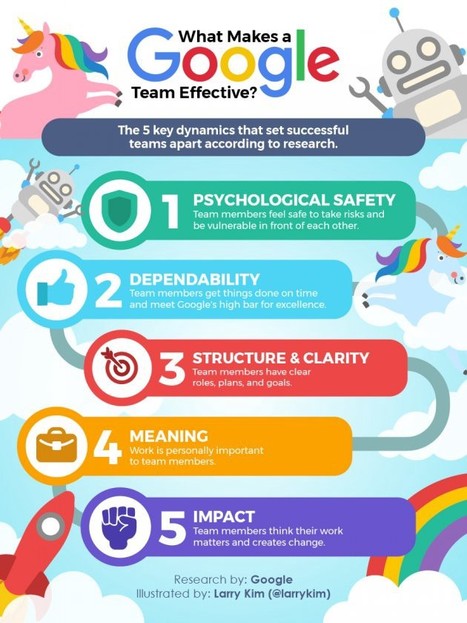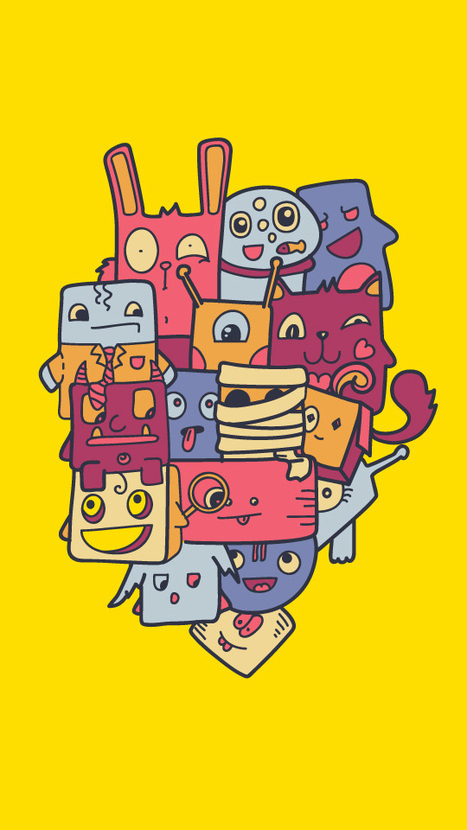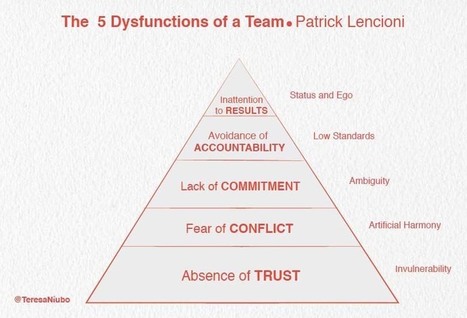 Your new post is loading...
 Your new post is loading...
One of the most common questions I get asked by senior managers is “How can we find more innovative people?” I know the type they have in mind — someone energetic and dynamic, full of ideas and able to present them powerfully. It seems like everybody these days is looking for an early version of Steve Jobs. Yet in researching my book, Mapping Innovation, I found that most great innovators were nothing like the mercurial stereotype. In fact, almost all of them were kind, generous, and interested in what I was doing. Many were soft-spoken and modest. You would notice very few of them in a crowded room. So the simplest answer is that you need to start by empowering the people already in your organization. But to do that, you need to take responsibility for creating an environment in which your people can thrive. That’s no simple task, and most managers have difficulty with it. Nevertheless, by following a few simple principles you can make a huge difference.
Via The Learning Factor
When we think productivity, we rarely think of workplace design as a major contributor or detractor, but compelling ongoing research shows that it plays a much larger role than initially thought. According to research published in the Journal of Experimental Psychology, an empowered office environment can increase worker productivity on cognitive tasks by 25%, and possibly more. Workspace design today is undergoing a major creative shift. We've gone from cubicles (people are productive in isolation) to open-plan spaces (collaboration leads to success) to what I believe is the next major step - integrated multi-function design which recognizes that people need multiple spaces based on their ongoing and changing needs within a business day. Instead of looking out across rows of cubicles, today's office worker needs a mix of team meeting rooms, open lounge-like areas, and private workspaces.
Via The Learning Factor
Groupthink is a worry for many organisations. Encouragingly, new research suggests it is not as widespread as might be feared.
Innovation is a team sport. Although creativity is a characteristic that is often used to describe individuals, the idea of the lone genius is a myth. Even famous inventors such as Thomas Edison where in reality representing the ‘work of many men’. Francis Jehl, a longtime assistant of Thomas Edison , used this phrase to describe the group of engineers who worked with Edison at his Menlo Park lab. On the journey from ideation to a successful product launch, innovation necessitates the interaction of multiple actors, across many departments, with different expertise and knowledge. In writing about the illustrious history of Bell Labs, James Gertner notes that, ‘…almost by definition, a single person or even a single group, could not alone create an innovation. The task [is] too variegated and involved’. Multidisciplinary collaboration is the stew in which creativity and innovation thrive. Such collaboration creates insights by exposing people to ideas from other disciplines besides their own area of specialization. This creates tremendous opportunities for serendipity. However, even in cross-functional teams, work is ultimately performed by individuals. Each person has to play their part. So how can we get the combined outputs of our teams to be more creative?
Via The Learning Factor
Want a team that says “Thank God It’s Monday”? Here’s how… One of the most important and core elements a company of people can be aligned on is their mission, vision and values about the company. These components are essential and powerful drivers for the exec team to efficiently achieve the success they want. They are also the key to having a highly engaged culture of team members who say ‘Thank God It’s Monday!’ Many companies don’t really think this is important to have these or have them nailed down. But that’s primarily because of one major flaw in the use of these terms. That one flaw is the integrity that runs behind the concepts of the Mission, Vision and Values Statements. Often there is a lot of misunderstanding about these words, mission, vision and values. And there are a lot of definitions out there.
Via The Learning Factor
1. Stop Compromising on Quality The level of quality you're working towards must be decided at the start of a project, not when staring down a deadline. Each product has a different level of optimal quality. For example, if you're working on a mobile game, your attitude towards data integrity--one aspect of quality--will be far different than if you're working on a finance or healthcare application. You must have this conversation up front and agree on what you'll measure and why. This is not just for the technical team, the business must agree as well.
Via The Learning Factor
Whatever your feelings toward your boss, the fact is that he or she got to that position because of some combination of experience, expertise, and training. In other words, they earned it. That doesn't mean you'll always agree with the decisions your boss makes. Sometimes you'll even be certain your boss is wrong—either on something small and harmless or much more consequential. So how do you challenge your boss respectfully and productively? It can be daunting to point out a difference of opinion to someone we report to. Many of us simply aren't great communicators when it comes to those in higher positions. But with a little effort and tact, you can disagree with your boss in a way that's respectful and gets things done.
Via The Learning Factor
|
It’s no surprise that Google, now part of Alphabet, loves data, and the company’s execs frequently share the revelations they find, such as their insights on mobile web use. But some of us would be surprised to discover that this unicorn company often turns its eye inward, analyzing information about its people to help improve its operations. A group of employees from Google’s People Operations section, the equivalent of an HR department, decided to complete an analysis to answer one question: What makes a Google team effective? Here’s a look at their approach and the startling revelations they had along the way.
Via The Learning Factor
How should teams of experts working on knowledge-intensive projects be structured? Should they be hierarchical? Or will flexible, self-organized groups perform better? Teams often struggle with how to get the most value from the members’ expertise, to minimize conflict, to integrate their diverse expertise, and to leverage it during all phases of a project. The traditional approach is to put the person with the most experience and expertise in charge — for example, a head coach or a chief programmer. The assumption is that this person has the expertise to make the best decisions about how to allocate tasks and responsibilities. Teams that adopt this model feature a rigid hierarchy, whereby final decisions are centralized through this single, formally designated individual.
Via The Learning Factor
You have a great product or service. You have the funds to make it happen. Now, the big question is "Do you have the people to stand by you and execute?" The biggest question for entrepreneurs today is how to create a culture to keep your dream growing to its full potential. The answer is by creating a place for people to continue to develop both professionally and personally. Dividing professional and personal development is an oxymoron. One feeds the other. And when you have an environment of mutual respect and open communication, more people want to hang around with you and make magic at work. The hardest part of work is the people piece. It needs on-going attention to keep productivity high and stress low. Here are 11 questions to ask yourself and your team to make sure you are heading in the right direction.
Via The Learning Factor
Teamwork: Reflexiones sobre cómo construir un equipo de alto rendimiento
If you think you have a lot of meetings today, you're in good company. One Harvard Business School professor estimates that there will be 11 million meetings taking place today in the United States. The unproductive ones (an estimated third) can cost a company an astounding amount of money. In a 2014 study of time usage, Bain & Company found that just one meeting of mid-level managers per week could cost an organization as much as $15 million per year. In an effort not to waste any more time—or money—on fruitless meetings, we’ve pulled together some pro tips for making any meeting more productive.
Via The Learning Factor
In the ideal meeting, all attendees participate, contributing diverse points of view and thinking together to reach new insights. But few meetings live up to this ideal, in large part because not everyone is able to effectively contribute. We recently asked employees at a large global bank a question: “When you have a contribution to make in a meeting, how often are you able to do so?” Only 35% said they felt able to make a contribution all the time. There are three segments of the workforce who are routinely overlooked: introverts, remote workers, and women. As a leader, chances are you’re not actively silencing these voices — it’s more likely that hidden biases at play. Let’s look at these biases and what you can do to mitigate their influence. Segment 1: The quiet ones The unconscious bias: Smart people think on their feet. What happens: A program manager calls a meeting to think through a resourcing issue. She summarizes the situation, shares results of a recent staffing analysis, and then tees up the discussion. This works great for extroverted thinkers (those that talk to think). But from the get-go, the introverted thinkers (those who think to talk) are at a disadvantage....
Via The Learning Factor
Remember your kindergarten report card, when you were evaluated on things like your ability to follow directions, name the colors, and sing the alphabet? It also included an early assessment of a skill that would influence your success for the rest of your life: the ability to "play well with others." The criteria were pretty basic at the time: share, wait your turn, don't hit or yell, help when someone is struggling. As you grow up, many of the same basic principles apply, but situations can be much more complicated for adults to play well together and still achieve desired results. Context and personal needs often create internal conflict when trying to weigh the needs of the few against the good of the whole. And as a leader, sometimes you have to make a conscious choice to make others unhappy. Still, with a little finesse, you can meet objectives and still all play in a happy sandbox. You may not satisfy everyone all of the time, but then working together to resolve conflicts, rather than just being pleasant all of the time, can make a team stronger.
Via The Learning Factor
|



 Your new post is loading...
Your new post is loading...



























It takes psychological safety, diversity, teamwork, and mission.